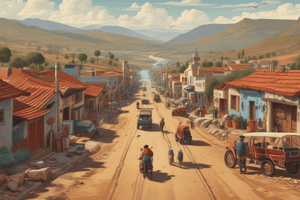Podcast
Questions and Answers
The structural transformation of the economy involves a shift from modern urban industry to traditional rural agriculture.
The structural transformation of the economy involves a shift from modern urban industry to traditional rural agriculture.
False (B)
The Lewis turning point is reached when the labor-to-land ratio is increasing.
The Lewis turning point is reached when the labor-to-land ratio is increasing.
False (B)
The Lewis two-sector development model perfectly reflects the institutional and economic realities of most contemporary developing countries.
The Lewis two-sector development model perfectly reflects the institutional and economic realities of most contemporary developing countries.
False (B)
The modern-sector labor market is assumed to be non-competitive in the Lewis model.
The modern-sector labor market is assumed to be non-competitive in the Lewis model.
The Lewis model assumes that there is surplus labor in urban areas and full employment in rural areas.
The Lewis model assumes that there is surplus labor in urban areas and full employment in rural areas.
Structural-change models only focus on the mechanism of underdeveloped economies transforming their domestic economic structures from a heavy emphasis on modern manufacturing to a more traditional subsistence agriculture.
Structural-change models only focus on the mechanism of underdeveloped economies transforming their domestic economic structures from a heavy emphasis on modern manufacturing to a more traditional subsistence agriculture.
The Lewis Theory of Economic Development suggests that industrialization occurs through the transfer of surplus labor from the modern industrial sector to the traditional agricultural sector.
The Lewis Theory of Economic Development suggests that industrialization occurs through the transfer of surplus labor from the modern industrial sector to the traditional agricultural sector.
The labor supply curve becomes negatively sloped as modern-sector wages and employment continue to grow.
The labor supply curve becomes negatively sloped as modern-sector wages and employment continue to grow.
Structural-change models employ the tools of neoclassical price and resource allocation theory to describe how the transformation process takes place.
Structural-change models employ the tools of neoclassical price and resource allocation theory to describe how the transformation process takes place.
The demand for manufactured goods is more concentrated in rural areas due to the need for processing and transportation.
The demand for manufactured goods is more concentrated in rural areas due to the need for processing and transportation.
W.Arthur Lewis' theory of development focuses on the transformation of a primarily industrial economy to a subsistence economy.
W.Arthur Lewis' theory of development focuses on the transformation of a primarily industrial economy to a subsistence economy.
A big push to urbanization is not necessary to achieve industrialization.
A big push to urbanization is not necessary to achieve industrialization.
Hollis B.Chenery's patterns of development analysis focuses on the role of agricultural transformation in economic development.
Hollis B.Chenery's patterns of development analysis focuses on the role of agricultural transformation in economic development.
The two-sector surplus labor model is a theoretical model of development that focuses on the transformation of a primarily industrial economy.
The two-sector surplus labor model is a theoretical model of development that focuses on the transformation of a primarily industrial economy.
Infrastructure, such as roads and railroads, is tradable and can be located anywhere.
Infrastructure, such as roads and railroads, is tradable and can be located anywhere.
Investing firms do not contribute to lowering the costs of other firms by using infrastructure.
Investing firms do not contribute to lowering the costs of other firms by using infrastructure.
There is overinvestment in training facilities due to the fact that entrepreneurs know that workers will not be enticed away by rival firms.
There is overinvestment in training facilities due to the fact that entrepreneurs know that workers will not be enticed away by rival firms.
Workers have a high demand for training because they know exactly what skills to acquire.
Workers have a high demand for training because they know exactly what skills to acquire.
Flashcards are hidden until you start studying




